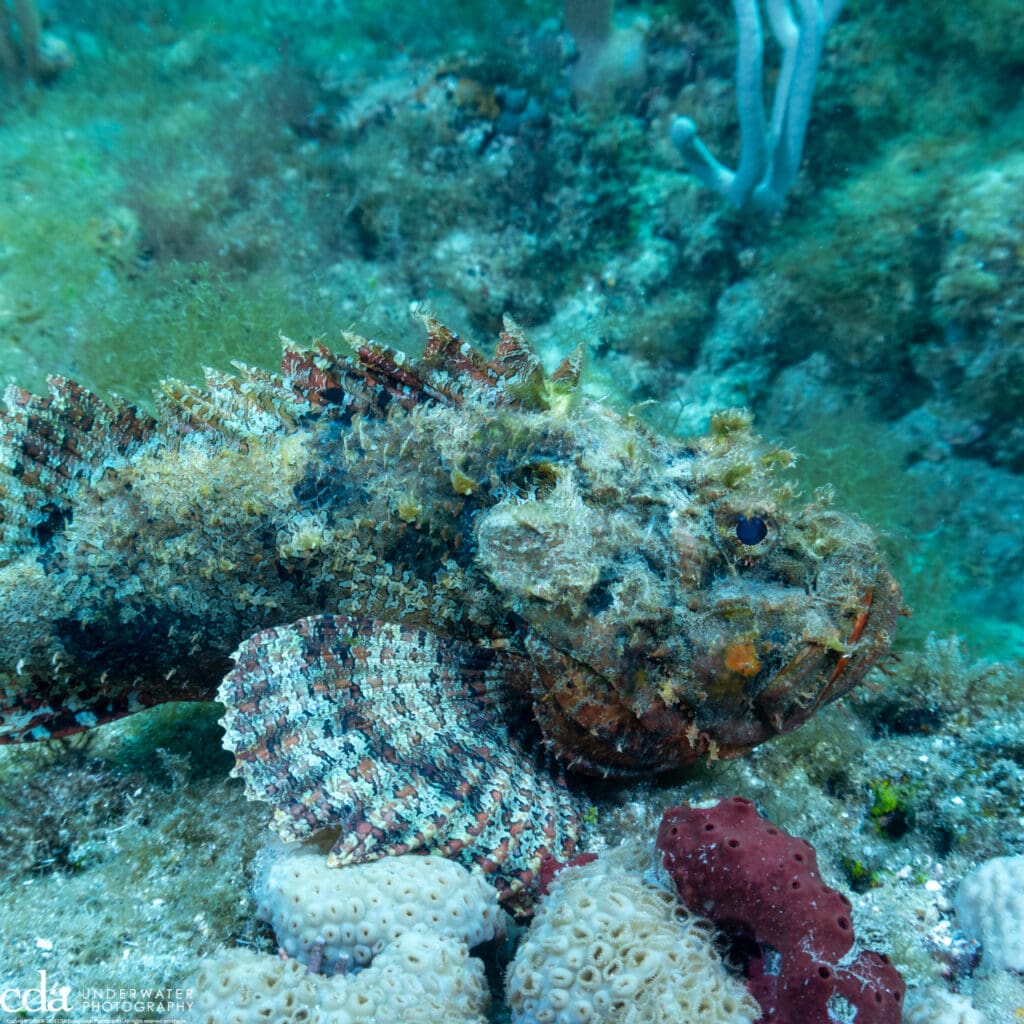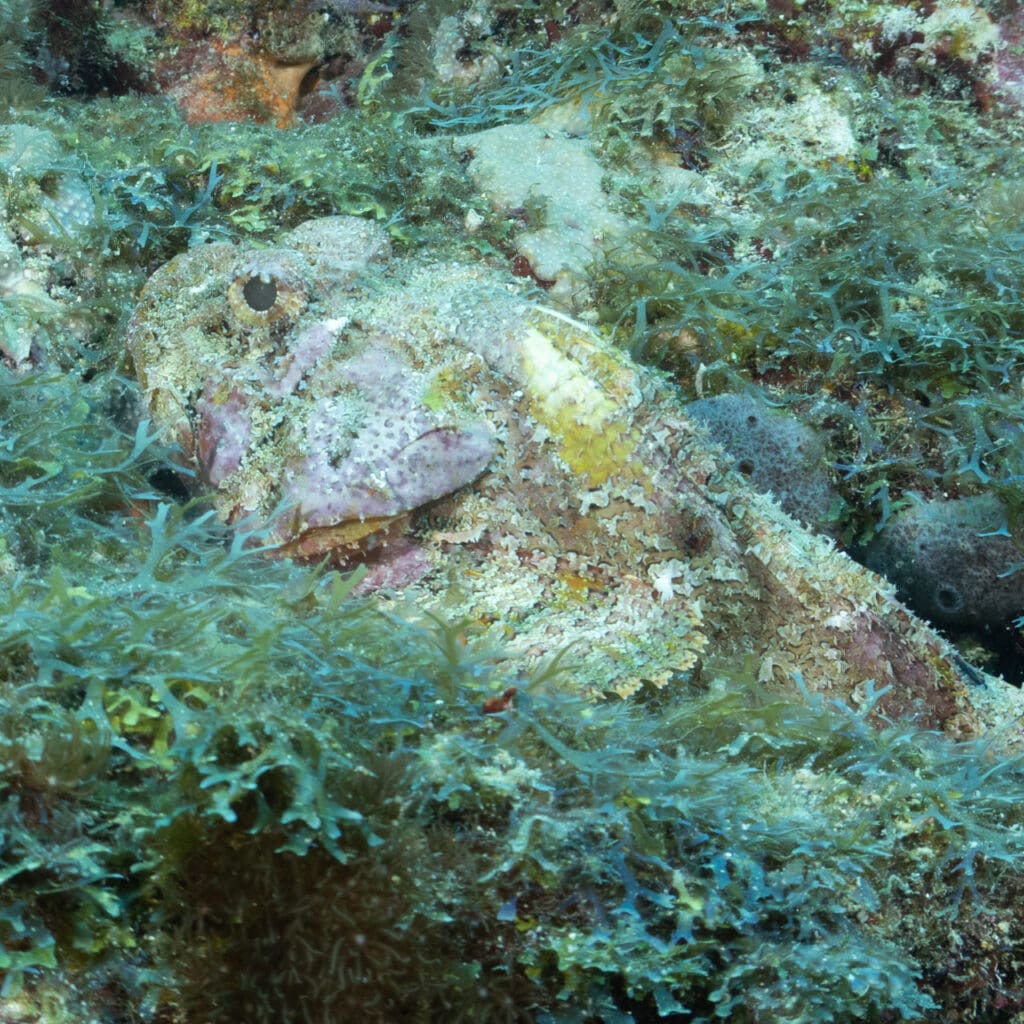Welcome back to another episode of #fff or Friday Fish Facts!
The spotted scorpionfish (Scorpaena plumieri) is one of the sneakiest reef-dwelling predators and is found all along the Florida reef tract. Known for its exceptional camouflage, venomous spines, and ambush hunting techniques, this fish is both a marvel of marine adaptation and a creature to be approached with caution by divers. It is a great example of why divers should always maintain their buoyancy and stay off the reef.
Appearance
The spotted scorpionfish is a stocky, bottom-dwelling fish that typically grows between 7 to 14 inches long. It has a broad head, large eyes, and a stout caudal (tail) fin. Its body is covered in mottled patterns that range from brown to reddish hues, helping it blend seamlessly into the reef environment. One of its most distinctive features is its pectoral fins, which have colorful markings, including dark areas with white spots. These markings contribute to its name and serve as a subtle warning to potential predators.
Camouflage and Defense Mechanisms
The spotted scorpionfish is a master of disguise, using its textured skin and coloration to mimic rocks, coral, and marine debris. This camouflage allows it to remain nearly invisible to both prey and predators. It can even change color slightly to better match its surroundings. Skip VandeLinde with Aqualife Divers is probably one of the best guides at spotting these sneaky fish we’ve ever dove with.

To understand just how good these fish are at disguising themselves, take a look at the same photo we used for the cover photo on this article, but zoomed out. Can you find the spotted scorpionfish now? Imagine if you were floating 8 feet above it!!
Beyond its camouflage, the spotted scorpionfish possesses venomous spines along its dorsal fin. These spines contain potent toxins that can cause intense pain and swelling if touched. While the fish is not aggressive, it will defend itself if disturbed, making it important for divers to maintain good buoyancy and awareness when exploring reefs where scorpionfish are present.
Meal Preferences and Hunting Strategy
The spotted scorpionfish is an ambush predator, relying on patience and stealth to capture its prey. It primarily feeds on small fish and crustaceans, waiting motionlessly for unsuspecting prey to come within striking distance. When the moment is right, it lunges forward with lightning-fast speed, swallowing its prey whole in a single gulp.
Unlike active hunters that chase their prey, the scorpionfish remains motionless, blending into the reef until an opportunity arises. This strategy allows it to conserve energy while maximizing its chances of a successful hunt. The invasive lionfish use a similar hunting strategy (ambush predation).
Prevalence on Fort Lauderdale Reefs and Dive Sites
The waters around Fort Lauderdale are home to a variety of scorpionfish, but the spotted scorpionfish is the most common. They are found in rocky reefs, coral outcrops, and marine debris, where they can hide among the natural structures.
Divers exploring South Florida’s reefs may encounter spotted scorpionfish at sites such as Blue Heron Bridge, the wrecks of Palm Beach and Broward County, and reefs of Miami Dade down to the Keys. However, spotting one requires keen observation, as their camouflage makes them incredibly difficult to detect.

Diving Precautions and Conservation
While the spotted scorpionfish is not considered endangered, divers should take care to avoid contact with these fish due to their venomous spines. Maintaining proper buoyancy and being mindful of where you place your hands can help prevent accidental envenomation. We have witnessed many new divers settle on the bottom at Blue Heron Bridge completely unaware that they are inches away from an unpleasant encounter with one of nature’s most well-defended animals.
Scorpionfish envenomation can be extremely painful and, in some cases, may require a trip to the emergency room. While most stings cause localized pain, swelling, and redness, severe reactions can include nausea, difficulty breathing, muscle weakness, and even systemic effects.
What to Do After a Sting
- Hot Water Immersion – Soaking the affected area in hot water (42-45°C or 107-113°F) for 30 to 90 minutes can help neutralize the venom and reduce pain.
- Pain Management – Over-the-counter pain relievers like ibuprofen or acetaminophen may help.
- Monitor for Severe Symptoms – If symptoms worsen or include difficulty breathing, dizziness, or extreme swelling, seek medical attention immediately.
- Wound Care – Clean the wound thoroughly to prevent infection.
If you have any questions, call DAN (Divers Alert Network). Their website is full of good information, and a phone call can give you much better information than an article on the internet. Their member number is +1-919-684-9111
When to Go to the ER
- Severe pain that does not improve
- Signs of an allergic reaction (difficulty breathing, swelling beyond the sting site)
- Systemic symptoms (nausea, vomiting, weakness)
- Deep puncture wounds that may require medical cleaning
Most cases can be managed with hot water immersion and pain relief, but if symptoms escalate, a trip to the ER is the safest option.
Final Thoughts
The spotted scorpionfish is a remarkable example of marine adaptation, combining camouflage, venomous defenses, and ambush hunting to thrive in the reefs near us. For divers, encountering one is both a challenge and a thrill—if they can spot it! Whether admired for its cryptic beauty or respected for its defensive capabilities, the spotted scorpionfish remains one of the ocean’s most intriguing inhabitants.
Out Scuba does not provide medical advice. Please contact DAN or a local medical professional if you get envenomated by a spotted scorpionfish.
Photo credit: © Copyright 2025 Christopher Duncan, CDA Underwater Photography. All Rights Reserved Worldwide. Some textual content created through generative AI.

